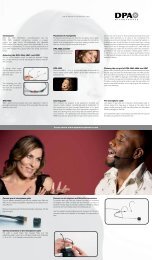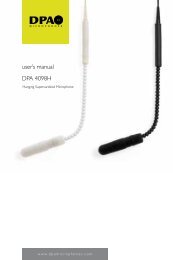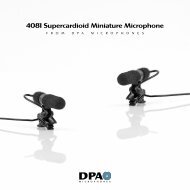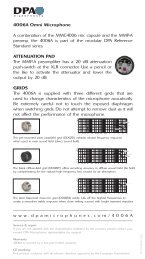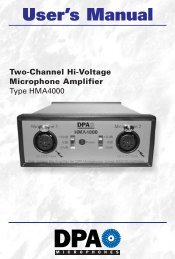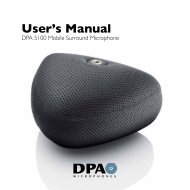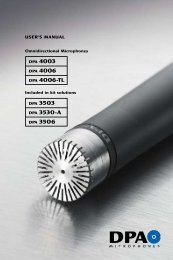The essentials of microphone technology â how ... - DPA Microphones
The essentials of microphone technology â how ... - DPA Microphones
The essentials of microphone technology â how ... - DPA Microphones
Create successful ePaper yourself
Turn your PDF publications into a flip-book with our unique Google optimized e-Paper software.
Testing your<br />
<strong>microphone</strong><br />
For live use you generally want as much suppression<br />
<strong>of</strong> <strong>of</strong>f-axis sound as possible. You only wish to hear<br />
the sound source itself. But very hard suppression <strong>of</strong>ten<br />
gives a very uneven <strong>of</strong>f-axis sound that will give the<br />
impression <strong>of</strong> ‘unnatural’ sound reproduction.<br />
Usually this compromise relates to the genre <strong>of</strong> music<br />
you play. An acoustic low volume genre really appreciates<br />
an open, natural and clean sound, whereas the<br />
louder the volume and the higher the need for gain<br />
before feedback, the higher tolerance towards ‘unnatural’,<br />
amplified sound.<br />
Never test a <strong>microphone</strong> alone. It’s always easier to hear<br />
a <strong>microphone</strong>’s character if you compare it to something.<br />
It is important to keep in mind that the acoustic memory<br />
<strong>of</strong> the human being is only a few seconds. You can’t<br />
rely on your memory <strong>of</strong> a <strong>microphone</strong> you tried last<br />
week, you need to be able to switch back and forth<br />
– A/B-testing. You can either test against an alternative<br />
<strong>microphone</strong> you are considering buying or one <strong>of</strong> your<br />
own <strong>microphone</strong>s that you are very familiar with.<br />
Compare their on-axis sound. For a studio <strong>microphone</strong><br />
this can be done at two different distances: 30 cm,<br />
which is the normal distance when recording a vocal,<br />
and for further testing, 3 cm on a loud sound source<br />
to check its upper dynamic range. If it’s a directional<br />
<strong>microphone</strong>, this will also help to check proximity effect<br />
and pop noise (more about this later).<br />
For all <strong>microphone</strong> testing using a really challenging<br />
sound source can be very revealing. Try testing with a<br />
large ring <strong>of</strong> keys. <strong>The</strong> sound <strong>of</strong> jangling keys has some<br />
very complex high frequencies that are difficult to reproduce.<br />
Good mics can, but lesser mics sound like you are<br />
crumbling a piece <strong>of</strong> paper.<br />
To test a live <strong>microphone</strong> you wish to hear its performance<br />
in its normal environment, so standing in front<br />
<strong>of</strong> a P.A. facing the stage would be ideal. Place the <strong>microphone</strong><br />
as it will normally be used, usually very close<br />
to the sound source, and again always test multiple mics<br />
at the same time.<br />
In live use gain before feedback is very important. You<br />
therefore need to test at quite high volumes to see<br />
which <strong>microphone</strong> feeds back first.<br />
Next compare their <strong>of</strong>f-axis sound. On directional <strong>microphone</strong>s<br />
you need to check the suppression <strong>of</strong> <strong>of</strong>f-axis<br />
sound. How hard is the suppression and – also very<br />
important – <strong>how</strong> good it sounds.<br />
-<br />
-<br />
Directional/cardioid<br />
vs. omnidirectional<br />
<strong>microphone</strong>s<br />
<strong>Microphones</strong> can have different directional characteristics.<br />
Omnidirectionals that pick up the sound all around<br />
them, and cardioids that mainly pick up the sound<br />
directly in front <strong>of</strong> them. Other directional patterns are:<br />
bidirectional/figure 8, supercardioid, hypercardioid, and<br />
wide cardioid.<br />
Generally a cardioid sounds appealing, since in a musical<br />
setting you only want the sound source and rarely<br />
want to record or amplify the surroundings. But directionality<br />
has a price and that sometimes is not worth<br />
paying.<br />
Directional <strong>microphone</strong>s need to have a much s<strong>of</strong>ter diaphragm<br />
than an omni. This s<strong>of</strong>tness results in handling,<br />
pop and wind noise which puts a limit to <strong>how</strong> close<br />
you can get to a vocalist, even when using pop-filters.<br />
A directional mic also suffers from proximity effect, which<br />
means that the closer you get to the sound source the<br />
louder the low frequencies get and vice versa.<br />
<strong>The</strong> proximity effect exhibited by the <strong>DPA</strong> 4011-TL<br />
Cardioid Microphone.<br />
<strong>The</strong> <strong>essentials</strong> <strong>of</strong> <strong>microphone</strong> <strong>technology</strong>: How to choose the right mic for the job




